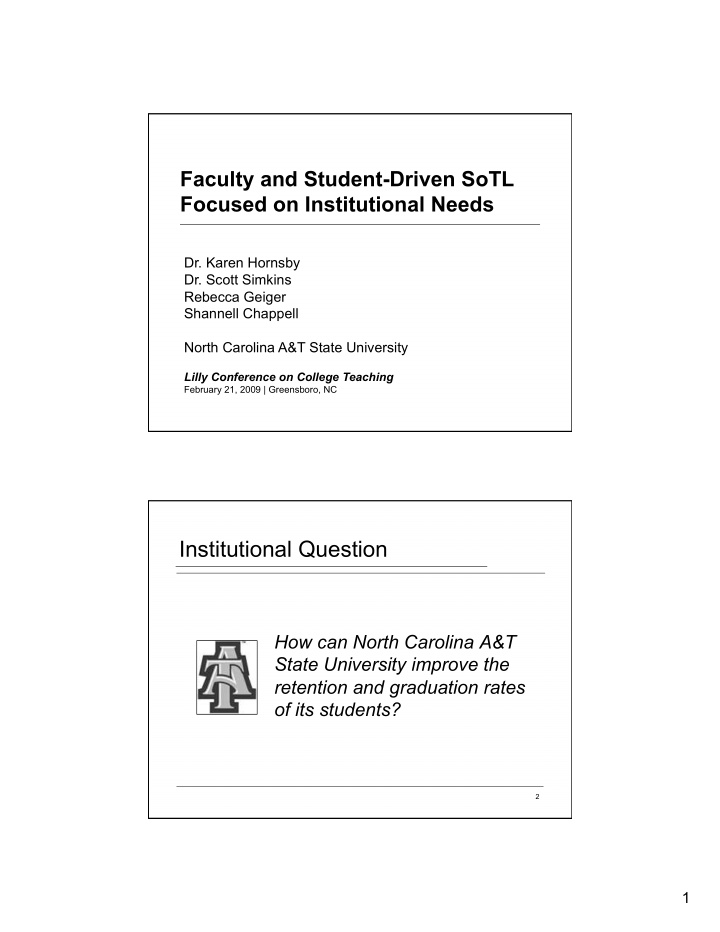



Faculty and Student-Driven SoTL Focused on Institutional Needs Dr. Karen Hornsby Dr. Scott Simkins Rebecca Geiger Shannell Chappell North Carolina A&T State University Lilly Conference on College Teaching February 21, 2009 | Greensboro, NC Institutional Question How can North Carolina A&T State University improve the retention and graduation rates of its students? 2 1
SoTL Research Question How can an educational institution effectively gather and use data to improve student learning? 3 Previous Use of Institutional Data � � IR Office as recorders and reporters � � Ad hoc gathering of data, driven by UNC System demands NSSE - 2003 FSSE - 2005 UNC Freshman, Sophomore, and Senior Surveys � � Result: Data publicly available but largely unused 4 2
Intentional Data Gathering/Analysis � � Intentional focus on learning � � Academy for Teaching and Learning as catalyst � � CASTL Institutional Leadership Program Team [faculty+students] � � Wabash/Provost Scholars [students] 5 The SoTL Process � � Starting with a question What do we know about the learning of our students and the learning environment at NC A&T? � � Gathering data Wabash National Study of Liberal Arts Outcomes 6 3
The SoTL Process � � Interpreting the data CASTL and Wabash/Provost Scholars developing “institutional narrative” / focus groups � � Going public Sharing the data with students, faculty, administrators, staff – “Does this make sense to you?” 7 What are we Learning? Wabash Results � � Institutional Narrative – Aspirational Gap � � Low performance on critical thinking, writing, and moral reasoning … with only small gains during freshman year � � Our freshman students spend little time studying (60% report < 10 hours/week) � � Students experience challenging courses but… also report problems with teaching practices 8 4
Digging Deeper Wabash Provost Scholars � � Focus Group Training � � Institutional Review Board (IRB) Training � � Focus Group Sessions 9 Focus Groups: Process What’s Involved? � � Generating Questions � � Scheduling Sessions � � Publicizing Sessions � � Gathering “data” � � Summarizing data � � Analyzing data – Bb Wiki Tool 10 5
Focus Groups: Challenges � � Learning Curve � � Participant Attendance � � Scholar interest / Load sharing 11 What are we Learning? Focus Groups � � Wabash/Provost Scholar Perspective � � Participants’ Responses 12 6
Next Steps � � Lilly presentation (Today) � � Making sense of focus group data (March) � � Presentation to Provost (April) � � Summary report (May) � � Fall: � � Deans’ Meeting � � Campus publications � � Student groups � � CASTL/ISSOTL meeting (Indiana) 13 What Next? � � Implementing Change Using Wabash data to promote changes in departmental curricula, pedagogical practices, and academic support What do the data mean for departments? 14 7
Institutional Commitment (?) 15 Take-aways � � Start with “What do we know?” � � Need for quantitative + qualitative data � � Student and faculty involvement (Wabash/ Provost Scholars + CASTL team) � � Holistic assessment (Wabash vs. CLA, MAPP, CAAP) – institutional narrative 16 8
Take-aways � � Going public (sharing results with students, faculty, administrators, staff) � � General results but local action (depts., courses, classrooms) � � Intentionality – focus on learning � � Continuing assessment – new questions 17 9
Recommend
More recommend